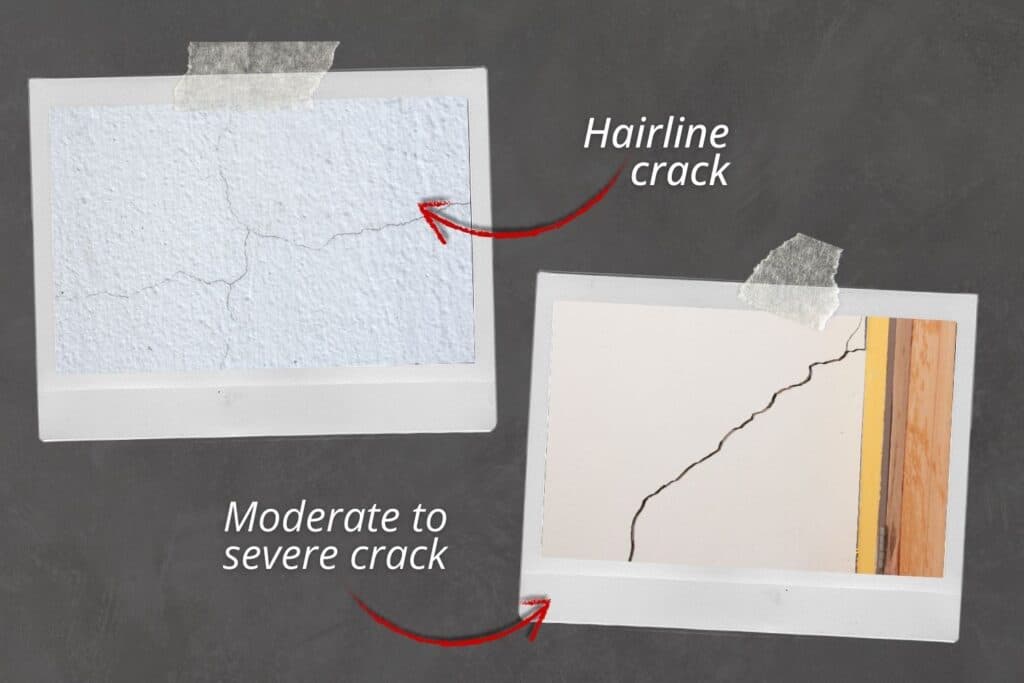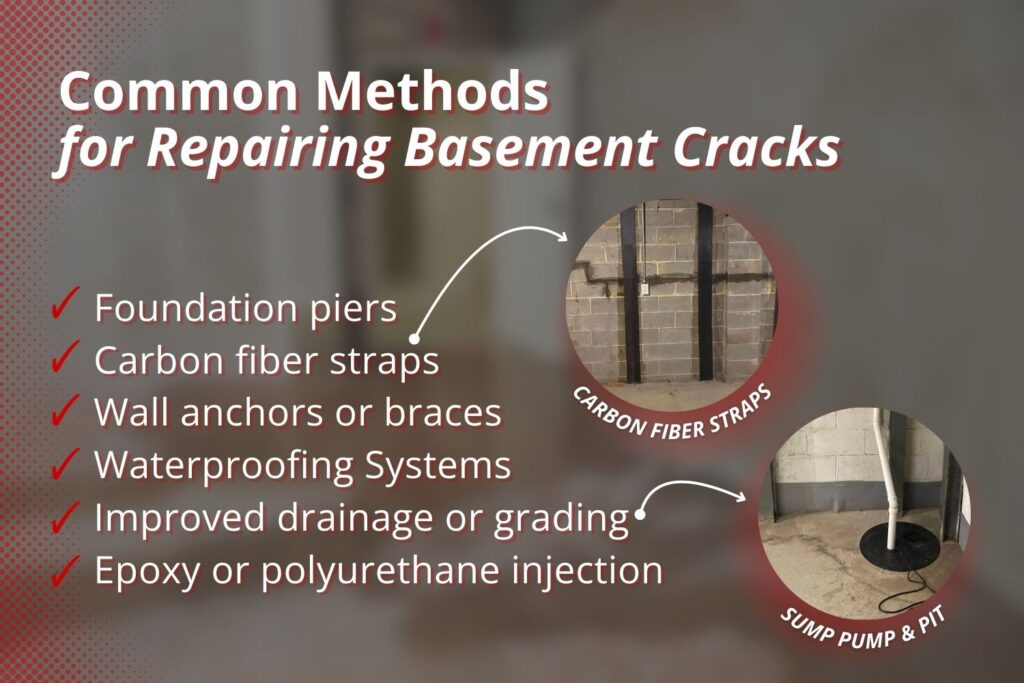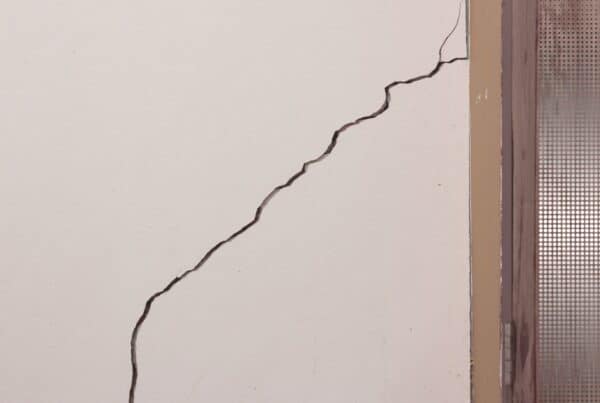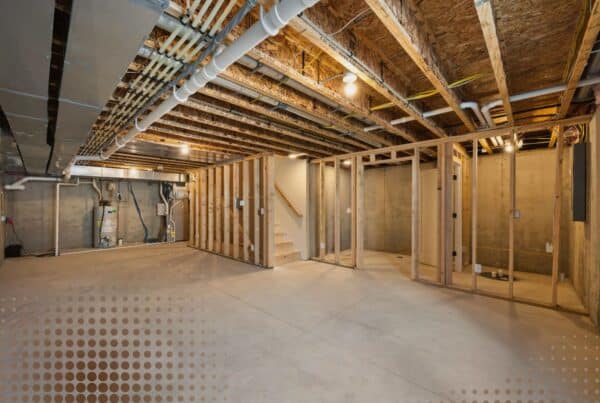This guide clears up the most common myths about basement crack repair and helps you understand what’s worth fixing, what can wait, and what might already be costing you.
A crack in the basement wall doesn’t always mean disaster. But it doesn’t mean you should ignore it either.
Some cracks are cosmetic. Others point to deeper structural or water problems. The trouble is, many homeowners either panic too quickly or brush it off too soon.
Misconception 1: Cracks Are Just Cosmetic
Hairline cracks in concrete are common, especially in newer homes or after seasonal changes. But not every thin crack is harmless.
Even small cracks can allow moisture to seep through, especially if they run vertically or appear near windows or pipe entries. Over time, that moisture can lead to:
- Mold or mildew growth
- Wall staining
- Rust on support elements
- Damage to stored items
- High humidity levels
A visual inspection isn’t enough to tell whether a crack is structural or superficial. The location, direction, and pattern of the crack all matter.
That’s why experienced inspectors use moisture meters and other tools to assess the real cause.
Bottom line? Not all cracks are serious, but all cracks are worth checking.

Misconception 2: You Can Seal a Crack Once and Be Done
Many DIY kits promise a “permanent” fix with epoxy or polyurethane injection. In some cases, that approach helps reduce water intrusion. But sealing a crack without knowing why it formed can make the problem worse.
If your home is still settling, or if water is pushing in from poor grading or hydrostatic pressure, the crack may widen over time. That can cause sealed joints to reopen or even force water through new points.
Smart repair starts with solving the underlying issue, not just sealing the symptom.
At Buckeye, we first identify what’s causing the basement crack, then determine the right repair for the structure, soil, and water conditions around your home.
Misconception 3: If It’s Not Leaking, It’s Fine
Cracks often go unnoticed until a rainy season or heavy snowmelt. But by then, the damage may already be happening behind the scenes.
Moisture intrusion can begin long before water becomes visible. Concrete is porous, and even a dry-looking crack can allow dampness into the foundation.
That moisture builds up over time and often shows up as musty odors, peeling paint, or efflorescence (the white powdery buildup on walls). Foundation cracks that don’t leak now can still shift, widen, or worsen later.
Proactive repair is always more affordable than water damage cleanup.
Misconception 4: Waterproofing Solves All Foundation Cracks
Waterproofing systems are important. Drainage tiles, sump pumps, and vapor barriers all help manage basement moisture. But these tools alone do not address structural movement.
If a crack is the result of foundation settlement or wall bowing, waterproofing may reduce visible leaks but won’t stop the wall from shifting.
Cracks caused by movement need reinforcement, not just water control.
That’s why Buckeye often combines crack repair with carbon fiber straps, wall anchors, or foundation piering if structural load-bearing walls are affected.
Misconception 5: Surface Crack Repair Works on All Wall Types
Poured concrete and block foundations crack differently. A common mistake is using the same patching method for both.
- Poured concrete walls typically develop vertical or diagonal cracks, which may be suitable for injection repair
- Block walls often crack in step patterns or show horizontal displacement, which usually points to external pressure or wall bowing
Surface sealing a block wall without addressing lateral pressure is like putting a bandage on a leaky pipe.
Matching the repair to the wall type is essential for long-term results.
What Basement Crack Repair Actually Involves
Depending on the crack’s size, direction, and cause, the repair may include:
- Epoxy or polyurethane injection for vertical cracks in poured concrete
- Carbon fiber straps to stabilize bowed walls and prevent further movement
- Wall anchors or braces for horizontal cracks and shifting block walls
- Exterior drainage or grading correction to reduce water pressure
- Foundation piers if the crack results from settlement or sinking

The Buckeye team uses detailed inspections and diagnostics to find the right mix of solutions for each home. No two foundations are exactly alike.
Signs a Basement Crack Needs Immediate Attention
Some cracks can wait. Others should be looked at right away. Watch for:
- Cracks wider than 1/8 inch
- Horizontal or step-shaped cracking in block walls
- Water staining, mold, or rust near the crack
- New cracks are forming near windows or doors
- Any sign of wall bowing or shifting
If you notice these signs, it’s time to bring in a professional. Even if a basement crack seems small, it may signal a larger issue developing beneath the surface that’s in need of repair.
Why Cracks Are Common in Ohio Homes
Many homes across Ohio are built on clay-heavy soil, which expands and contracts with moisture. These soil shifts can apply pressure to basement walls, especially in wet seasons or drought cycles.
Older homes may also have minimal drainage systems, which allow water to pool near the foundation and add hydrostatic pressure. Frost heave, tree roots, and construction shortcuts can also lead to cracking over time.
Cracks are common, but that doesn’t mean they’re normal. Every crack tells a story about how your home is handling the environment around it.
How Much Does Basement Crack Repair Cost?
The cost of repairing a crack in your basement varies widely, depending on the size of the crack, wall type, and whether structural reinforcement is needed.
Simple crack injections may range from $250 to $750 per crack, and other solutions can be even more of an investment, but waiting too long can cost you far more.
If water intrusion or foundation movement goes unchecked, repairs may involve…
- Mold remediation: often $1,500 to $6,000, depending on the spread
- Wall replacement or structural rebuilds: $10,000 to $30,000 or more
- Basement flooring or drywall replacement due to moisture damage: $2,000 to $10,000, depending on the size of the affected area
In most cases, fixing the crack early is the cheapest and most effective option. Preventing damage is always easier than undoing it.
When to Get an Inspection
If you’re unsure whether a basement crack is serious, the best move is to schedule a professional inspection. Catching a problem early is always easier and cheaper than repairing major water or foundation damage later.
Our inspectors look at:
- Crack shape, size, and direction
- Moisture readings behind wall surfaces
- Soil grading and drainage near the home
- Previous patch jobs or sealing attempts
- Signs of foundation movement or pressure
We also provide photo documentation and clear next steps so you understand what’s happening and what needs to be done, if anything.
Common Questions Homeowners Ask
Is it alright to just monitor a crack for a while?
Yes, but only if it’s small and stable. If the crack is growing or showing moisture, it should be addressed sooner rather than later.
Can I seal a crack myself with a DIY kit?
It depends. DIY kits may work for very minor cracks, but without knowing what caused them, the fixes might not last.
What if I already had waterproofing done?
Waterproofing helps, but if the crack is structural, you’ll still need reinforcement or stabilization.
How fast do cracks get worse?
That depends on soil conditions, drainage, and load stress. Some cracks remain stable for years, while others widen quickly.
Will repairing a crack improve my home’s value?
Yes. Documented, professional repairs show buyers that the home has been properly maintained and reduce the chance of deal-breaker concerns during the sale.
Final Thoughts
Basement cracks aren’t always signs of a major problem, but they should never be ignored. The biggest mistake homeowners make is assuming a crack is fine without understanding what caused it.
Getting ahead of the issue means fewer surprises and fewer costly repairs down the road.
If you’ve spotted cracks in your basement or want peace of mind before buying or selling a home, Buckeye Basement Solutions is here to help. Our team provides clear answers, honest recommendations, and reliable repairs designed to last.
Schedule your inspection or repairs today and get expert eyes on the cracks before they grow into something bigger.



